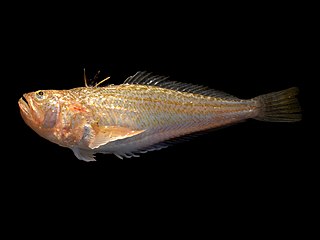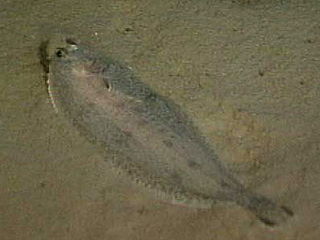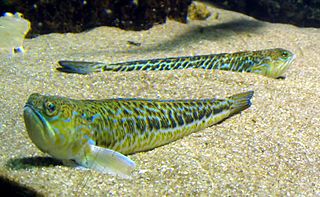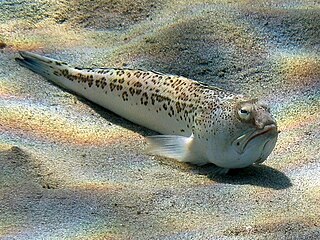
Weevers are nine extant species of fishes of family Trachinidae, order Trachiniformes, part of the Percomorpha clade. They are long, mainly brown in color, and have venomous spines on their first dorsal fin and gills. During the day, weevers bury themselves in sand, just showing their eyes, and snatch prey as it comes past, which consists of shrimp and small fish.

The Urolophidae are a family of rays in the order Myliobatiformes, commonly known as stingarees or round stingrays. This family formerly included the genera Urobatis and Urotrygon of the Americas, which are presently recognized as forming their own family Urotrygonidae. Stingarees are found in the Indo-Pacific region, with the greatest diversity off Australia. They are sluggish, bottom-dwelling fish that have been recorded from shallow waters close to shore to deep waters over the upper continental slope. Measuring between 15 and 80 cm long, these rays have oval to diamond-shaped pectoral fin discs and relatively short tails that terminate in leaf-shaped caudal fins, and may also have small dorsal fins and lateral skin folds. Most are smooth-skinned, and some have ornate dorsal color patterns.

Dactyloptena orientalis, known commonly as the Oriental flying gurnard or purple flying gurnard among other vernacular names, is a species of marine fish in the family Dactylopteridae. Their name is derived from the French word 'gurnard' meaning to grunt, for the grunting sound this fish makes.

The lesser weever is a venomous weever of the family Trachinidae, in the order Perciformes, and the class Actinopterygii. It is generally found on the sandy sea beds of the open sea, near the shore. Lesser weevers may sting swimmers badly if disturbed in the water, and fishermen when they clean their fishing nets.

The greater weever is a benthic and demersal venomous marine fish of the family Trachinidae. The greater weever is widely distributed along the eastern Atlantic coastline from Norway to Morocco, extending to the Mediterranean, Aegean and Black Seas. Trachinus draco has been shown to occur in depths ranging from shallow water up to -150 meters where it inhabits mostly muddy or sandy grounds. Trachinus draco is mostly and notoriously known for its venomous spines that can inflict serious injuries on humans through accidental stinging. Because of these spines and its potent venom it is classified as one of the most venomous fishes in the Mediterranean. The name “weever” is thought to originate from the Anglo-Saxon word “wivre” which translates as “viper”.

The witch, known in English by a variety of other common names including the witch flounder, pole flounder, craig fluke, Torbay sole, and grey sole, is a species of flatfish from the family Pleuronectidae. It occurs on both sides of the North Atlantic Ocean on muddy sea beds in quite deep water. In northern Europe it has some importance in fisheries as a food fish.

Kuhl's maskray, also known as the blue-spotted stingray, blue-spotted maskray, or Kuhl's stingray, is a species of stingray of the family Dasyatidae. It was recently changed from Dasyatis kuhlii in 2008 after morphological and molecular analyses showed that it is part of a distinct genus, Neotrygon. The body is rhomboidal and colored green with blue spots. Maximum disk width is estimated 46.5 cm (18.3 in). It is popular in aquaria, but usually not distinguished from the blue-spotted ribbontail ray. The ribbontail has a rounded body, is a brighter green with brighter blue and more vivid spots, but Kuhl's maskray is larger. The stingray's lifespan is estimated at 13 years for females and 10 years for males. The blue-spotted stingray preys on many fish and small mollusks. It is also generally found from Indonesia to Japan, and most of Australia. Kuhl's maskray also is targeted by many parasites, such as tapeworms, flatworms, and flukes.

The spotted eagle ray is a cartilaginous fish of the eagle ray family, Aetobatidae. As traditionally recognized, it is found globally in tropical regions, including the Atlantic, Pacific and Indian Oceans. Recent authorities have restricted it to the Atlantic with other populations recognized as the ocellated eagle ray and Pacific white-spotted eagle ray. Spotted eagle rays are most commonly seen alone, but occasionally swim in groups. They are ovoviviparous, the female retaining the eggs then releasing the young as miniature versions of the parent.

Alepes is a genus containing five extant species of tropical marine fishes in the jack family, Carangidae. They are commonly known as scads, a term applied to many genera of carangid fishes. Their body form, however, differs from these other scads by being much more ovate in shape, more similar to the larger jacks taken as game fish, although scads are generally much smaller. They are found in coastal waters throughout the Indo-West Pacific region.

Trachinus is a genus of weevers, order Perciformes that consists of seven extant species. Six of the genus representatives inhabit the waters of Eastern Atlantic Ocean, but only one, Trachinus cornutus, inhabits the South-Eastern Pacific Ocean. Three of the Atlantic species occur near the coasts of Europe. An eighth extinct species, T. minutus, is known from Oligocene-aged strata from the Carpathian Mountains, while a ninth species, also extinct, T. dracunculus, is known from middle-Miocene-aged strata from Piemonte, Italy.
The spotted dragonet is a species of dragonet native to the eastern Atlantic Ocean and the Mediterranean Sea where it occurs at depths of from 45 to 650 metres. This species is important to local peoples engaged in subsistence fishing.
Scorpaena azorica, the Azores scorpionfish, is a species of marine ray-finned fish belonging to the family Scorpaenidae, the scorpionfishes. This fish occurs in the Northeastern Atlantic region in European waters. This fish is found in demersal and marine environments in subtropical waters, generally on hard bottoms. The maximum recorded length is 9.8 centimetres (3.9 in).

The starry weever, or streaked weever, Trachinus radiatus, is a fish of the family Trachinidae widespread in the eastern Atlantic from Gibraltar to the Gulf of Guinea, and probably further south; it is also known from the Mediterranean Sea. A marine subtropical fish, it grows up to 50 cm (20 in) in length.
The Guinean weever is a fish of the family Trachinidae, widespread in the eastern Atlantic along the coasts of Africa from Mauritania to Angola. A marine, tropical, demersal fish, it grows up to 35 centimetres (14 in) length.
The sailfin weever, Trachinus collignoni, is a fish of the family Trachinidae, order Perciformes, and class Actinopterygii. Widespread in the Eastern Atlantic along the tropical coast of west Africa, Gabon and Congo, probably further north and south. Marine tropical fish, up to 15 centimetres (5.9 in) in length.
Trachinus pellegrini, the Cape Verde weever, is a fish of the family Trachinidae. Widespread in the eastern Atlantic along the coasts of Senegal to Nigeria, including the Canary Islands and Cape Verde, and also reported from Mauritania, it is a marine tropical demersal fish, up to 20 centimetres (7.9 in) in length. The species was named and described by Jean Cadenat in 1937 and the specific name honours the French ichthyologist Jacques Pellegrin (1873–1944), who worked at the Muséum National d'Histoire Naturelle in Paris.
The striped weever, Trachinus lineolatus, is a fish of the family Trachinidae. Widespread in the Eastern Atlantic from Guinea-Bissau to São Tomé Island and Gabon, it is a marine tropical demersal fish, up to 15 centimetres (5.9 in) in length.
Trachinus cornutus is a fish of the family Trachinidae, order Perciformes, and class Actinopterygii. Widespread in the southeastern Pacific along the coasts of Chile, it is a marine subtropical demersal fish.

The stargazing stonefish is a species of stonefish native to the Indian Ocean and the western Pacific Ocean where it is found on muddy bottoms in estuaries. This venomous species is also a minor component of local commercial fisheries. This species grows to a length of 8 centimetres (3.1 in) SL. This species is the only known member of the genus Trachicephalus.
A weevers, or Weeverfish, are a group of fish species in the family Trachinidae.













